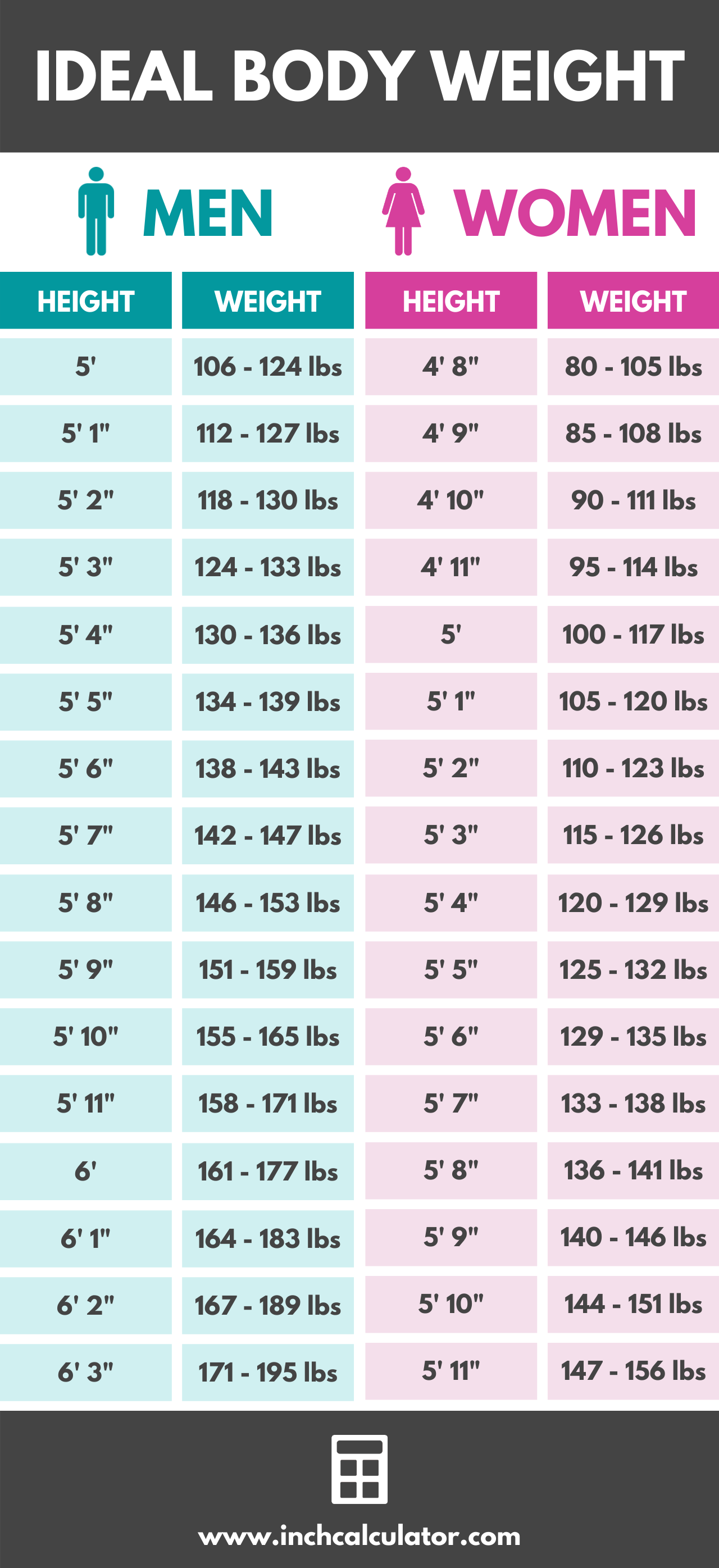Ideal Body Weight Calculator
Calculate your ideal body weight for your height using various formulas with the IBW calculator.
On this page:
How to Calculate Your Ideal Body Weight
Ideal body weight (IBW) is an estimate of an individual’s healthy weight based on certain parameters, most notably height and gender. This value corresponds to a favorable nutrition status.
Maintaining a healthy body weight is associated with a decreased risk of chronic health issues and early mortality.[6] On the other hand, obesity is associated with an increased prevalence of cardiovascular disease, hypertension, diabetes, and even certain forms of cancer.[6]
Calculating what your IBW is one piece of information that you can use to ensure you are maintaining a healthy weight.
Ideal Body Weight Formulas
Several different formulas have been developed over the years to estimate ideal body weight. Interestingly, these equations were first introduced to estimate drug metabolism and clearance from the body as research has found that these factors relate more to ideal body weight than actual total body weight.[7]
Most of the ideal body weight formulas were derived using population data and weight trends. These ideal body weight equations all share a general agreement among the different height-weight tables from which they were based.[7]
Since these formulas all give similar results, any one of these equations may be used to estimate IBW.
The Devine Formula
The first IBW equation was introduced by Ben J. Devine in 1974 to allow estimation of drug clearances in obese patients.[8] This is still one of the most commonly used formulas to calculate ideal body weight in clinical practice today.
The Devine Formula uses sex and height to determine ideal body weight. This equation was initially based on estimates of ideal body weight and not population studies.[7]
Men:
Ideal Body Weight [kg] = 50 + (2.3 × (height [in] – 60))
Women:
Ideal Body Weight [kg] = 45.5 + (2.3 × (height [in] – 60))
So, in this formula, a 5’5″ female would have an IBW of:
45.5 + (2.3 × 5) = 57 kg
To convert this to pounds, multiply by 2.2.
57 kg × 2.2 lbs/kg = 125.4 pounds
Hamwi Formula
The Hamwi formula is very similar to the Devine formula. However, the Hamwi equation also uses body frame in predicting ideal body weight. The base equation assumes a medium frame. Some people suggest that this formula can be adjusted for body frame by increasing by 10% for those with a large body frame or decreasing by 10% for those with a small body frame.
Men:
Ideal Body Weight [kg] = 48 kg + (2.7 × (height [in] – 60))
Women:
Ideal Body Weight [kg] = 45.5 kg + (2.2 × (height [in] – 60))
Sometimes this common equation is also seen written using imperial units:
Men:
Ideal Body Weight [lbs] = 106 + (6 × (height [in] – 60))
Women:
Ideal Body Weight [lbs] = 100 + (5 × (height [in] – 60))
Robinson Formula
The Robinson formula was developed on the basis of the 1959 Metropolitan Life Insurance Company height-weight tables.[7] This equation was created to better assess ideal body weight for drug dosing.
Men:
Ideal Body Weight [kg] = 52 + (1.9 × (height [in] – 60))
Women:
Ideal Body Weight [kg] = 49 + (1.7 × (height [in] – 60))
Using this formula, a 5’5″ female would have an IBW of:
49 kg + (1.7 × 5) = 57.5 kg
To convert this to pounds, multiply by 2.2.
57.5 kg × 2.2 lbs/kg = 126.5 pounds
Miller Formula
Similar to the Robinson equation, the Miller equation was formulated on the basis of the Metropolitan Life Insurance Company height-weight tables. However, the Miller equation is slightly different as it uses more recent data, based on the 1983 tables instead of the 1959 tables that Robinson used.[7]
Men:
Ideal Body Weight [kg] = 56.2 + (1.41 × (height [in] – 60))
Women:
Ideal Body Weight [kg] = 53.1 + (1.36 × (height [in] – 60))
Using this formula, a 5’5″ female would have an IBW of:
53.1 + (1.36 × 5) = 60 kg
To convert this to pounds, multiply by 2.2.
60 kg × 2.2 lbs/kg = 132 pounds
Ideal Body Weight: A Range Rather Than One Number
One of the downfalls of calculating ideal body weight is that it only gives one number based on an individual’s height and gender. These formulas do not take into account other factors, such as lean body mass, genetic makeup, physical activity, or age.
And, unlike BMI, there is no set “healthy range” formally associated with ideal body weight. Plus, using a different equation will give you a slightly different value for ideal body weight.
Studies have even found that in practice, it might be more useful to use BMI ranges instead of IBW formulas for men and women.[9] However, you can use a BMI chart in combination with ideal body weight calculations to determine your ideal body weight range.
Healthy Weight Range
For most people, a healthy weight range will fall within the healthy BMI range of 18.5 to 25. Of course, individual circumstances may mean that some people with higher muscle mass may fall outside of these numbers. However, in general, this is a good range to follow.
BMI Chart
| Weight Category | BMI |
|---|---|
| Underweight | <18.5 |
| Healthy Weight | 18.5 – 24.9 |
| Overweight | 25 – 29.9 |
| Class 1 Obesity | 30 – <35 |
| Class 2 Obesity | 35 – <40 |
| Class 3 Obesity | >40 |
How Much Should You Weigh
When determining your ideal body weight, there are a number of variables you should take into account. The equations for ideal body weight take into account gender and height, but these are only part of what should be considered when determining a healthy body weight.
Other factors, such as your body type, frame size, health conditions, muscle mass, and physical activity also are important determining factors in your ideal body weight. Therefore, the number that you get when using the ideal body weight formulas should be taken into consideration with these additional factors.
Ideal Weight Chart
The National Institute of Health has also developed a chart that combines BMI and body weight ranges based on height to aid in determining your ideal, healthy body weight.[12]
| Height | Healthy Weight (Ideal Body Weight) |
Overweight | Obesity | Extreme Obesity |
|---|---|---|---|---|
| BMI: 19 – 24.9 | BMI: 25 – 29 | BMI: 30 – 39 | BMI: 40 – 54 | |
| 60″ | 97-123 lbs | 128-148 lbs | 153-199 lbs | 204-276 lbs |
| 61″ | 100-127 lbs | 132-153 lbs | 158-206 lbs | 211-285 lbs |
| 62″ | 104-131 lbs | 136-158 lbs | 164-213 lbs | 218-295 lbs |
| 63″ | 107-135 lbs | 141-163 lbs | 169-220 lbs | 225-304 lbs |
| 64″ | 110-140 lbs | 145-169 lbs | 174-227 lbs | 232-314 lbs |
| 65″ | 114-144 lbs | 150-174 lbs | 180-234 lbs | 240-324 lbs |
| 66″ | 118-148 lbs | 155-179 lbs | 186-241 lbs | 247-334 lbs |
| 67″ | 121-153 lbs | 159-185 lbs | 191-249 lbs | 255-334 lbs |
| 68″ | 125-158 lbs | 164-190 lbs | 197-256 lbs | 262-354 lbs |
| 69″ | 128-162 lbs | 169-196 lbs | 203-263 lbs | 270-365 lbs |
| 70″ | 132-167 lbs | 174-202 lbs | 209-271 lbs | 278-376 lbs |
| 71″ | 136-172 lbs | 179-208 lbs | 215-279 lbs | 286-386 lbs |
| 72″ | 140-177 lbs | 184-213 lbs | 221-287 lbs | 294-397 lbs |
| 73″ | 144-182 lbs | 189-219 lbs | 227-295 lbs | 302-408 lbs |
| 74″ | 148-186 lbs | 194-225 lbs | 233-303 lbs | 311-420 lbs |
| 75″ | 152-192 lbs | 200-232 lbs | 240-311 lbs | 319-431 lbs |
| 76″ | 156-197 lbs | 205-238 lbs | 246-320 lbs | 328-443 lbs |
These formulas provide a good starting point to estimate your ideal body weight to ensure that you fall within a healthy range for your height. They are also used as part of calculating adjusted body weight.
This is just one more tool when putting together a fitness and nutrition program to meet your health goals, and it should be combined with other factors such as lean body mass, body fat percentage, genetics, and age when computing your own healthy ideal body weight.

References
- Robinson, J., Lupkiewicz, S., Palenik, L., Lopez, L., Ariet, M., Determination of ideal body weight for drug dosage calculations, The American Journal of Hospital Pharmacy, 1983, 40(6), 1016-9. https://pubmed.ncbi.nlm.nih.gov/6869387/
- Miller, D., Carlson, J., Lloyd, B., Day, B. , Determining ideal body weight (and mass), Am J Hosp Pharm, 1983, 40, 1622–5. https://pubmed.ncbi.nlm.nih.gov/6638023/
- Pai, M., Paloucek, F., The Origin of the “Ideal” Body Weight Equations, Annals of Pharmacotherapy, 2000, 34(9), 1066-1069. https://journals.sagepub.com/doi/10.1345/aph.19381
- Peterson, C, Thomas, D., Blackburn, G., and Heymsfield, S., Universal equation for estimating ideal body weight and body weight at any BMI, The American Journal of Clinical Nutrition, 2016, 103(5), 1197-1203. https://www.ncbi.nlm.nih.gov/pmc/articles/PMC4841935/
- Centers for Disease Control and Prevention, Assessing Your Weight, https://www.cdc.gov/healthyweight/assessing/index.html
- Fontana, L., & Hu, F. B., Optimal body weight for health and longevity: bridging basic, clinical, and population research, Aging Cell, 2014, 13(3), 391–400. https://doi.org/10.1111/acel.12207
- Pai, M. P., & Paloucek, F. P., The origin of the 'ideal' body weight equations, The Annals of pharmacotherapy, 2000, 34(9), 1066–1069. https://pubmed.ncbi.nlm.nih.gov/10981254/
- McCarron, M. M., & Devine, B. J., Clinical Pharmacy: Case Studies: Case Number 25 Gentamicin Therapy, Drug Intelligence & Clinical Pharmacy, 1974, 8(11), 650–655. https://journals.sagepub.com/doi/10.1177/106002807400801104
- Shah, B., Sucher, K., & Hollenbeck, C. B., Comparison of ideal body weight equations and published height‐weight tables with body mass index tables for healthy adults in the United States, Nutrition in clinical practice, 2006, 21(3), 312-319. https://aspenjournals.onlinelibrary.wiley.com/doi/abs/10.1177/0115426506021003312
- World Health Organization, A healthy lifestyle - WHO recommendations, https://www.who.int/europe/news-room/fact-sheets/item/a-healthy-lifestyle---who-recommendations
- Centers for Disease Control and Prevention, About Adult BMI, https://www.cdc.gov/healthyweight/assessing/bmi/adult_bmi/index.html
- Expert Panel on the Identification, Treatment of Overweight, Obesity in Adults (US), National Heart, Lung, Blood Institute, ... & Kidney Diseases (US), Clinical guidelines on the identification, evaluation, and treatment of overweight and obesity in adults: the evidence report (No. 98), National Institutes of Health, National Heart, Lung, and Blood Institute, 1998, https://www.nhlbi.nih.gov/health/educational/lose_wt/BMI/bmi_tbl.pdf



